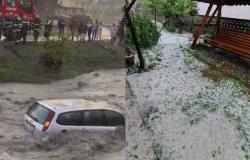A dust cloud of Saharan origin also reached Prahova. The phenomenon was also favored by the rains.
This morning, the cars in Ploiesti were covered with a layer of reddish dust, whose origin is the Sahara desert.
According to the National Meteorological Administration, this air mass loaded with Saharan dust will be over Romania on Wednesday, April 24, and the dust deposits will be observed in the areas and in the intervals in which it will rain.
On Wednesday afternoon, the air mass laden with Saharan dust particles will move northeast and away from the country.
What does Saharan dust contain and what impact does it have on people’s health?
Specialist doctors from the Victor Babeș Hospital in Timișoara explained that the fine sand, from the dust cloud component, contains magnesium, iron, calcium and phosphorus granules, even mercury. Exposure to this dust is harmful to health. The concentration of harmful elements is very high and can affect not only people with respiratory problems but also healthy ones.
Inhaled dust particles reach the respiratory tract where they are detected by epithelial cells and activate macrophages (a subcategory of blood cells with a role in the immune system) and immune cells.
They release cytokines and other inflammatory molecules that have effects on the lung in various respiratory diseases. The cardiovascular system can also be affected. Toxicological studies have shown that dust and sand particles can cause inflammatory lung damage.
People who have various lung diseases, for example those with asthma, may experience an exacerbation of symptoms. Also, in the case of people with chronic respiratory diseases, they can develop episodes of wheezing and even mild respiratory failure. At the same time, we noticed an increase in the number of respiratory infections that required hospitalization. In the case of people who do not have lung diseases, the wave of Saharan dust can lead to the development of seasonal allergic rhinitis with irritation of the throat, nose and even lacrimation.
On the days when the presence of a cloud of Saharan dust is announced, we recommend avoiding travel, especially for people with serious lung diseases, and wearing a protective mask.






